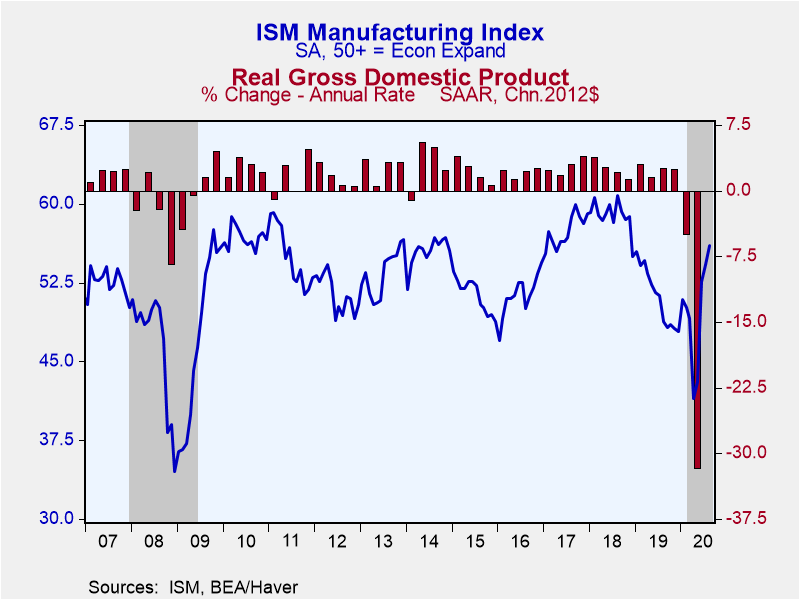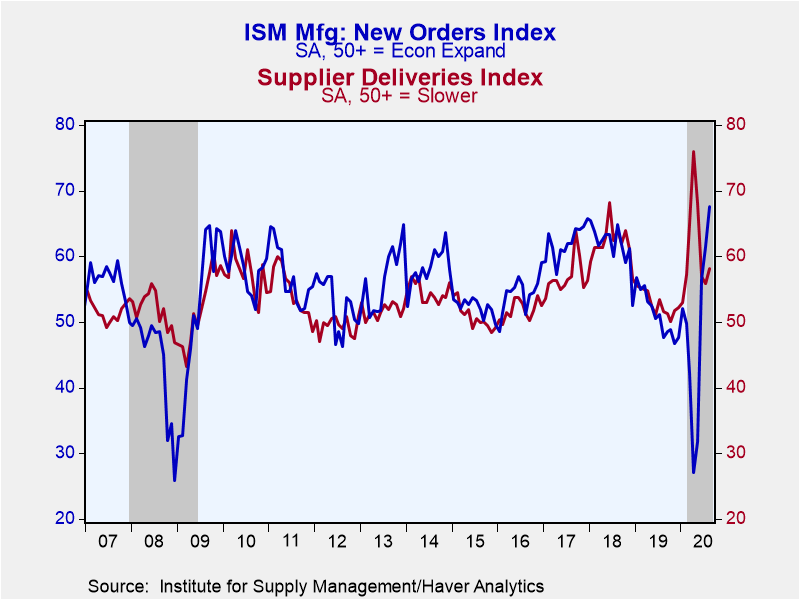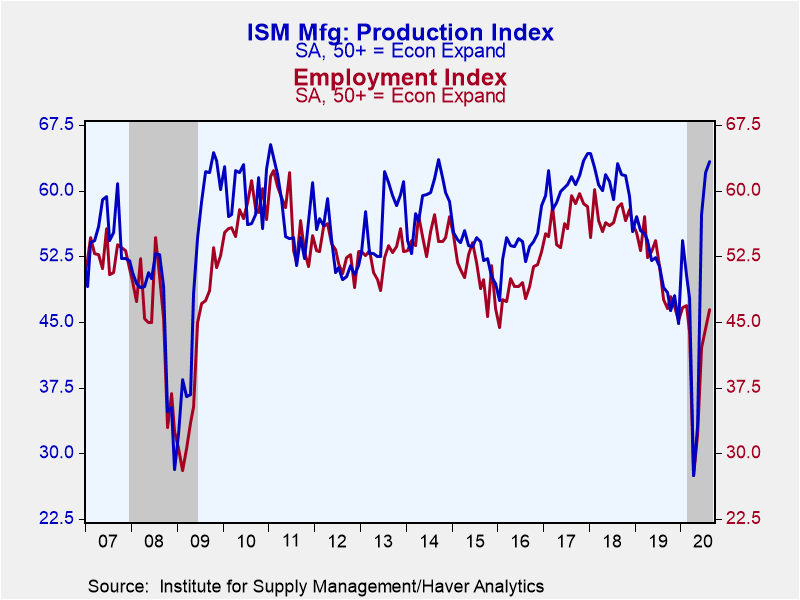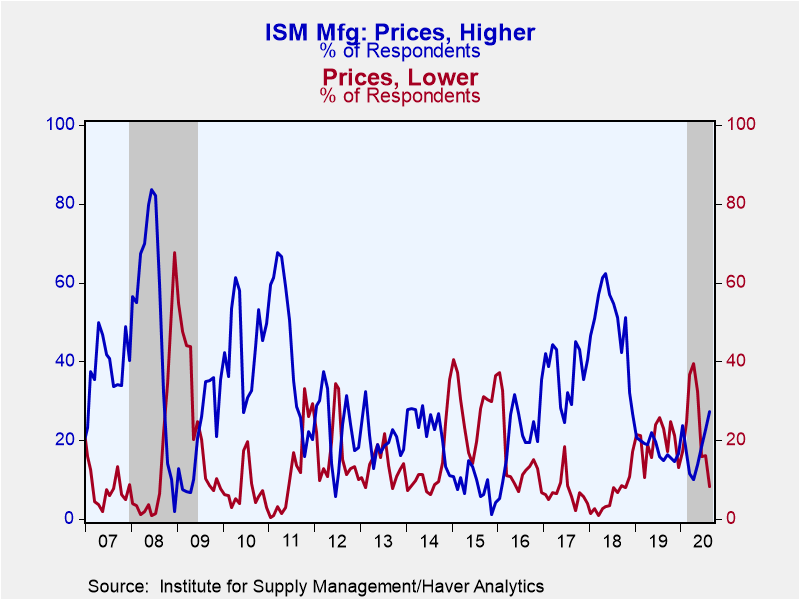 Global| Sep 01 2020
Global| Sep 01 2020ISM Manufacturing Index Is Unexpectedly Strong in August
by:Tom Moeller
|in:Economy in Brief
Summary
• Factory sector activity expands for third straight month. • Breadth of component improvement is wide. • Price index continues to increase. The factory sector remains on a firm footing. The Institute for Supply Management (ISM) [...]
• Factory sector activity expands for third straight month.
• Breadth of component improvement is wide.
• Price index continues to increase.
The factory sector remains on a firm footing. The Institute for Supply Management (ISM) reported that its Composite Index of Manufacturing Sector Activity increased to 56.0 during August after rising to 54.2 in July. A level of 54.7 was expected in the Action Economics Forecast Survey. It was the third consecutive month above the break-even level of 50 following three months below 50. August was the highest reading since November 2018. During the last 15 years, there has been a 49% correlation between the composite index and the quarterly change in real GDP.
The production index rose to 63.3 from 62.1 in July. A slightly lessened 38% (NSA) of respondents reported higher production while a greatly lessened 13% reported a decline. The new orders index similarly strengthened to 67.6 from 61.5. This is well above the April low of 27.1. A fairly steady 40% (NSA) of survey respondents reported higher new orders while a greatly lessened 13% reported a decline. Also supporting the composite was improvement in the supplier delivery measure which rose to 58.2, indicating more bottlenecks in the supply chain. Nevertheless, the figure remained below its high of 76.0 in April. Countering these gains was a sharp decline in the inventory measure to 44.4, keeping it significantly below the February 2018 peak of 55.0.
Also increasing during August was the employment measure to 46.4 from 44.3 in July. It was the highest point in six months. Nevertheless, as it stayed below 50, it continued to indicate declines in the number of factory-sector jobs. The index peaked at 60.1 in February 2018. A slightly increased 17% (NSA) of respondents reported higher payrolls while a fairly steady 24% reported declines.
With the improvement in factory sector activity came a rise in pricing power. The prices paid index surged to 59.5 (NSA). It compared to 53.2 in July and was the highest level since November 2018. Prices recently declined from February to May. An improved 27% of respondents reported higher prices, the most since November 2018, while a greatly lessened 8% reported declines.
Other series in the ISM report indicated improvement. The export order measure strengthened to 53.3 from 50.4. It was the highest level since January and increased from a low of 35.3 in April. The import series surged to 55.6 following readings below 50 from February through June, while the order backlog measure again rose sharply.
The ISM figures are based on responses from over 400 manufacturing purchasing executives from 20 industries, which correspond to their contribution to GDP in 50 states. These data are diffusion indexes where a reading above 50 indicates expansion. The figures from the Institute for Supply Management can be found in Haver's USECON database; further detail is found in the SURVEYS database. The expectations number is available in Haver's AS1REPNA database.
The Illusion of Wage Growth from the Federal Reserve Bank of San Francisco is available here.
| ISM Mfg (SA) | Aug | Jul | Jun | Aug'19 | 2019 | 2018 | 2017 |
|---|---|---|---|---|---|---|---|
| Composite Index | 56.0 | 54.2 | 52.6 | 48.8 | 51.2 | 58.9 | 57.4 |
| New Orders | 67.6 | 61.5 | 56.4 | 47.6 | 51.1 | 61.6 | 62.1 |
| Production | 63.3 | 62.1 | 57.3 | 48.9 | 51.2 | 60.9 | 60.9 |
| Employment | 46.4 | 44.3 | 42.1 | 47.6 | 50.9 | 56.9 | 56.8 |
| Supplier Deliveries | 58.2 | 55.8 | 56.9 | 51.6 | 52.9 | 62.0 | 56.8 |
| Inventories | 44.4 | 47.0 | 50.5 | 48.4 | 49.8 | 52.9 | 50.4 |
| Prices Paid Index (NSA) | 59.5 | 53.2 | 51.3 | 46.0 | 49.1 | 71.7 | 65.0 |
Tom Moeller
AuthorMore in Author Profile »Prior to joining Haver Analytics in 2000, Mr. Moeller worked as the Economist at Chancellor Capital Management from 1985 to 1999. There, he developed comprehensive economic forecasts and interpreted economic data for equity and fixed income portfolio managers. Also at Chancellor, Mr. Moeller worked as an equity analyst and was responsible for researching and rating companies in the economically sensitive automobile and housing industries for investment in Chancellor’s equity portfolio. Prior to joining Chancellor, Mr. Moeller was an Economist at Citibank from 1979 to 1984. He also analyzed pricing behavior in the metals industry for the Council on Wage and Price Stability in Washington, D.C. In 1999, Mr. Moeller received the award for most accurate forecast from the Forecasters' Club of New York. From 1990 to 1992 he was President of the New York Association for Business Economists. Mr. Moeller earned an M.B.A. in Finance from Fordham University, where he graduated in 1987. He holds a Bachelor of Arts in Economics from George Washington University.










